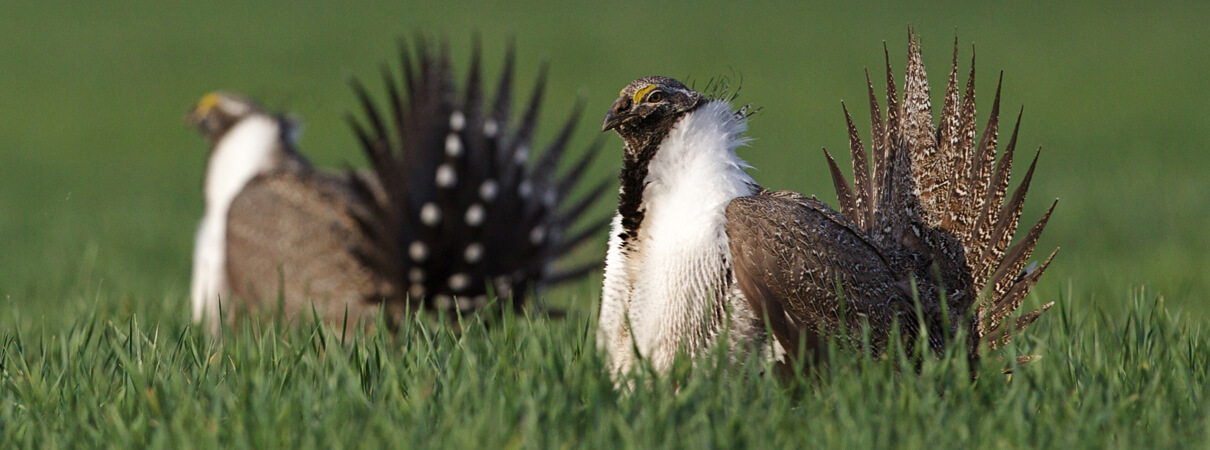To Prevent Habitat Loss, Balance Conservation and Development
The Obama administration is making important strides toward creating a better balance between conservation and development on federal lands, which provide habitats for a vast array of birds and other wildlife. Initiatives include the Greater Sage-Grouse conservation planning strategy, a moratorium on coal leasing, and a Presidential Memorandum that directs land-management and wildlife agencies to mitigate development impacts to federal lands and endangered wildlife.
A good example of achieving a better balance is the Greater Sage-Grouse conservation strategy, a massive planning effort that updated management plans affecting 67 million acres of sagebrush habitat. The plans aim to redirect development pressures for oil and gas, mining, towers and transmission lines away from the most essential habitat for this rapidly declining species.

Greater Sage-Grouse by Tom Reichner, Shutterstock
Doing so will also conserve habitat for other species of concern, such as Sage Thrasher, Brewer's Sparrow, Sagebrush Sparrow, and Loggerhead Shrike. If all goes as hoped, these new management plans—combined with habitat restoration and enhancement and conservation easements on private lands—will leave Greater Sage-Grouse and 350 other species of wildlife that inhabit sagebrush country enough room to flourish.
Potential Threats from Habitat Loss
The sage grouse conservation planning strategy, however, is not yet complete. A key part of the plan is a mining moratorium for 10 million acres of the most important sagebrush habitat, including 2.7 million acres of public and National Forest System lands in Nevada. That decision is now going through the public review process.
Additional conservation measures also need to be put in place for critically important wintering habitat where large numbers of Greater Sage-Grouse congregate. New large-scale oil drilling and transmission line projects threaten significant amounts of priority grouse habitat, and need to be addressed.

Sage Thrasher by Martha Marks, Shutterstock
Another part of the plan yet to be developed promises to do that and mitigate for all development impacts. The Presidential Memorandum on Mitigation tasks federal managers with protecting irreplaceable resources, avoiding and minimizing development impacts, and requiring fair compensation for unavoidable impacts. Depending on how it is implemented, the President's new mitigation strategy could go a long way to better balance development with conservation, and ensure that imperiled species like the Greater Sage-Grouse have a fighting chance.
Ensuring a Balance for the Future
Some members of the U.S. Congress have unfairly criticized this sage grouse conservation strategy. So have development interests and several state governments, including Nevada, that are now using the legislative and legal processes to try to overturn the federal management plans. So far these efforts have not succeeded. A legislative amendment to nullify the plans failed in 2015, and lawsuits to overturn the plans have yet to be heard in court.

Sagebrush Sparrow by Greg Lavaty
We at American Bird Conservancy will be advocating for the grouse as the conservation strategy is put in place. We'll be closely watching to see that the plans prove effective at reducing habitat loss and bringing back the birds, and defending against renewed efforts in Congress to derail them. It is crucial the plans be fully implemented, the most important habitats be protected from mining, and the mitigation policy put in place to ensure that future development will be in balance with conservation.
 Steve Holmer is Senior Policy Advisor at American Bird Conservancy. He has more than 20 years of experience working to conserve endangered wildlife, including for the Unified Forest Defense Campaign and as Campaign Coordinator of American Lands Alliance. Steve also directs the Bird Conservation Alliance, a network of more than 200 groups that builds congressional support for bird conservation programs.
Steve Holmer is Senior Policy Advisor at American Bird Conservancy. He has more than 20 years of experience working to conserve endangered wildlife, including for the Unified Forest Defense Campaign and as Campaign Coordinator of American Lands Alliance. Steve also directs the Bird Conservation Alliance, a network of more than 200 groups that builds congressional support for bird conservation programs.


















































